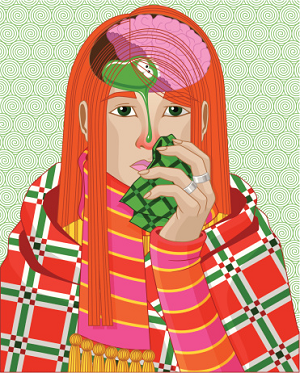Dec 21, 2025
Dec 21, 2025
 Sinus infection, or sinusitis, is an inflammation of the sinuses and nasal passages. A sinus infection can cause a headache or pressure in the eyes, nose, cheek area, or on one side of the head. A person with a sinus infection may also have cough, fever, terrible smell breath and nasal congestion with thick nasal secretions. Sinusitis is classified as acute (sudden onset) or chronic (long term, the most common type).
Sinus infection, or sinusitis, is an inflammation of the sinuses and nasal passages. A sinus infection can cause a headache or pressure in the eyes, nose, cheek area, or on one side of the head. A person with a sinus infection may also have cough, fever, terrible smell breath and nasal congestion with thick nasal secretions. Sinusitis is classified as acute (sudden onset) or chronic (long term, the most common type).
Anatomy of the sinuses:
The human skull contains four major pairs of hollow air-filled cavities called sinuses. These are connected to the space between the nostrils and the nasal passage.
Sinuses help insulate the skull, reduce its weight, and allow the voice to resonate within it. The four major pairs of sinuses are the:
The sinuses contain biological protection against foreign infection habitually from outside. If interference occurs that affects the normal host defenses inside the sinuses, those defenses may allow bacteria, which are normally present in the nasal passages, to enter any of the sinuses. Once there, the bacteria may stick to the lining cells and cause a sinus infection.
Acute sinusitis usually lasts less than nine to eleven weeks or occurs no more than three times per year with each episode lasting no longer than 10 days. Medications are usually effective against acute sinusitis. Successful treatment counteracts damage done to the mucous lining of the sinuses and surrounding bone of the skull.
Chronic sinusitis lasts longer than eight weeks or occurs more than four times per year with symptoms usually lasting more than 20 days.
The sinuses are covered with a mucus layer and cells that contain little hairs on their surfaces called cilia. These help trap and propel bacteria and pollutants outward. The ostiomeatal complex (OMC) connects the nasal passage to the paranasal sinuses.
The ayurvedic approach:
Ayurveda describes this as Pratishyay. This is a Kafa and Pitta type malady. When Pitta associates with this combination then feverish condition comes into observation. The acute sinusitis is called as Pratishyay and chronic is known as Jeern Pratishyay or Peenus. However there is a complete scientific study of the cause of this disease available in the ayurveda but here I think that the management will be right choice of a long-suffering person.
Therapeutic management:
Yashtimadhu, Ginger, Piper longum, Piper Nigrum, clove, nutmeg, beetle leaves and Gulbanafsha are some most common herbs. Apart from them there are plenty of herbal formulations are being used with very effective performance in this illness, like Gaujivhyadi kwath and Sitopaladi churn. Abhrak Bhasm, Balsudha or Tankan Bhasm, LaxmiVilas ras Nardiya, Basant malti Laghu or swarn, Ras sindhur, Chitrak Haritaki, Agastya Haritaki, Anu Tail and Shadbindu tail.
PanchKarma:
Narayan tail Madhyam for Abhyang.
Sthanik Sweden (local steaming) by vapor of Dashmooladikwath.
Shirodhara and shirobasti,
Nasya with Kaifal or Katfal Nasya.
Ahar the food:
The patients are advised to avoid cold food items like ice cream, cold beverages, yogurt, tobacco abusing and constipating food. Patients should take one glass of hot water with many times in a day.
Yoga:
Kapal bhati Pranayama, Antarik Kumbhak Pranayama, meditation on third eye or Agya chakra are recommendable yoga asanas.
Nauli and Neti are categorically praiseworthy but both Kriyas belong to Hath Yoga therefore without any proper training no one try them, or else this can be cause of damage.
Image (c) Gettyimages.com
05-Sep-2013
More by : Dr. Jayvant Kharat